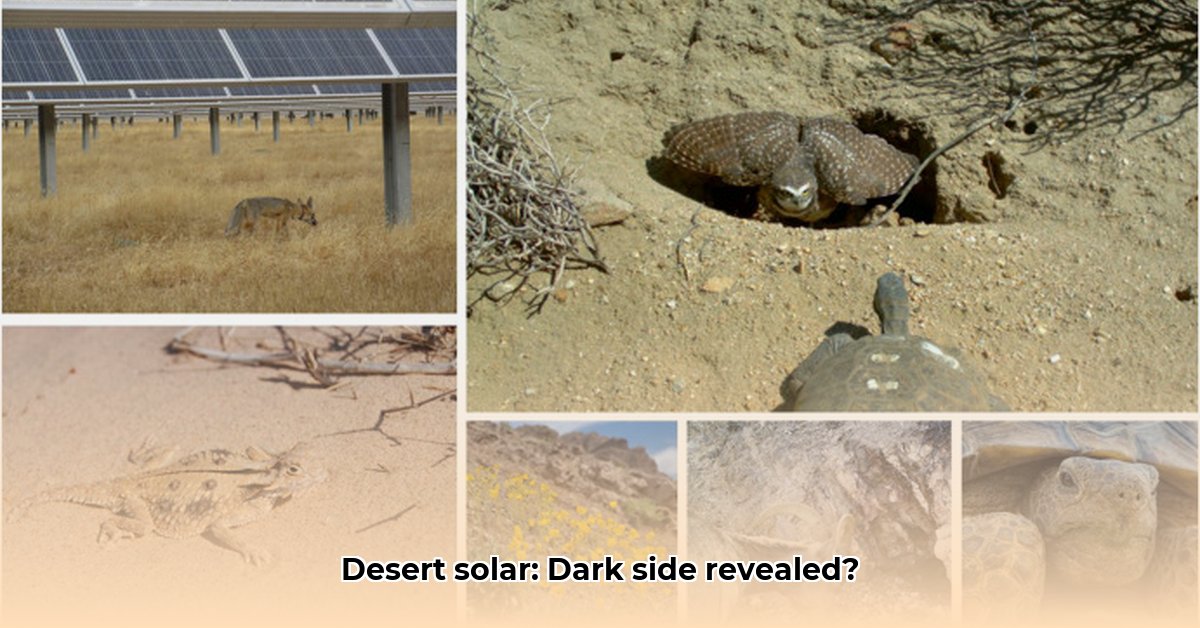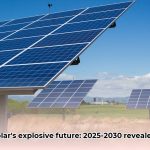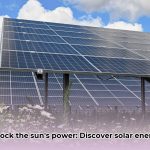We all know solar power is a game-changer in the fight against climate change, and giant solar farms in the desert seem like a perfect solution. But are these massive projects really as eco-friendly as they appear? This article takes a hard look at the potential downsides of building solar farms in deserts, exploring the surprising ways they can harm delicate desert environments. We’ll uncover the hidden costs – from harming wildlife and plants to stretching already scarce water supplies – and show you how we can build solar farms that are both powerful and planet-friendly. We’ll dig into the details, offering practical solutions and expert advice to ensure solar energy helps us, and the desert, thrive for years to come. For a broader perspective on solar energy challenges, see this article on [solar energy drawbacks](https://txgenco.com/drawbacks-of-using-solar-energy).
Unveiling Hidden Threats: How Solar Development Impacts Fragile Desert Ecosystems
The desert, often pictured as a desolate wasteland, actually teems with surprisingly diverse life, perfectly adapted to its harsh conditions. Think tiny desert tortoises, hardy cacti, and elusive night creatures all making a living in this seemingly barren landscape. Building massive solar farms in these areas can have some unexpected negative impacts on the environment. Let’s explore these challenges and see what we can do to solve them, while also considering potential innovative solar technologies.
Habitat Loss and Disruption of Desert Life: Understanding the Ecological Cost
Imagine a bustling city suddenly popping up in the middle of a quiet neighborhood. That’s what happens when we build large-scale solar projects in the desert. Construction disrupts the natural habitat, breaking up the land and destroying the homes of many plants and animals. These creatures, already adapted to a challenging environment, may struggle to find new places to live and may even disappear entirely from these areas. For example, the Mojave Desert Tortoise, already a threatened species, faces further habitat fragmentation from solar development. The Sonoran Desert, known for its unique cacti and wildlife, is also at risk. It’s like tearing a hole in a carefully woven tapestry – the damage ripples outward, affecting the whole ecosystem. Some species, unique to the desert, could become even more endangered, emphasizing the need for biodiversity conservation strategies.
Water Scarcity: Examining Water Use in Desert Solar Farms
Deserts are famously dry, and water is a precious resource. Building and operating solar farms, however, requires a surprising amount of water. Manufacturing the solar panels themselves is a water-intensive process. Keeping these panels clean also uses a significant amount of water, especially in dusty desert environments. For instance, large solar farms can use hundreds of thousands of gallons of water annually for cleaning, drawing from already stressed aquifers. Additionally, changes in temperature and rainfall patterns near the solar farms can further stress the already limited water resources, impacting the survival of plants and animals that depend on them. The Colorado River, a vital water source for many desert regions, is increasingly strained, and solar farms add to this pressure. This highlights the importance of sustainable water management in these projects.
Heat Island Effect: Analyzing Desert Temperatures on the Rise Due to Solar Farms
Solar panels, while fantastic at capturing sunlight, also absorb and radiate heat. This can create what’s known as a “heat island” effect, raising the local temperature around the solar farm. Studies have shown that large solar installations can raise local temperatures by several degrees Celsius. This increased heat adds to the already intense desert climate, making survival tougher for desert plants and animals accustomed to specific temperature ranges. We’re essentially replacing a naturally reflective surface with a heat-absorbing one, making an already hot place even hotter. The Merriam’s kangaroo rat, for example, is highly sensitive to temperature changes, and increased heat can disrupt its breeding cycle. What strategies can we employ to mitigate the thermal impact of solar installations?
Soil Degradation: Evaluating a Foundation Under Pressure from Construction
The construction of solar farms involves heavy machinery which can compact the soil, making it difficult for water to penetrate and plants to grow. Adding to this, the use of herbicides and pesticides to control weeds around the panels can contaminate the soil further, harming soil organisms and potentially impacting the wider ecosystem. This degradation of the soil can have long-lasting effects on the desert environment, affecting plant life and the animals that depend on them. In the Atacama Desert in Chile, mining activities for materials used in solar panels have led to significant soil degradation and water contamination, demonstrating the far-reaching impacts of solar energy development. Exploring methods for soil rehabilitation in solar fields is crucial.
Solar Panel Recycling: Addressing Waste Disposal Challenges
Solar panels don’t last forever. Eventually, they need to be replaced, creating a significant waste disposal problem, especially in remote desert areas with limited recycling infrastructure. Solar panels contain potentially hazardous materials, such as cadmium and lead. Improper disposal of these panels can lead to the release of toxic substances into the environment, further polluting the fragile desert ecosystem. We need better ways to recycle and dispose of these panels to minimize this environmental impact and promote responsible solar panel disposal. The International Renewable Energy Agency (IRENA) estimates that by the 2050s, the world could face up to 78 million tonnes of solar panel waste.
Here are three pivotal points from the article:
- Solar farms can disrupt desert habitats, threatening unique plant and animal life.
- Water usage for panel cleaning and manufacturing strains scarce desert water resources.
- The heat island effect from solar panel absorption increases local temperatures, impacting desert ecosystems.
Solutions for a Sustainable Future: Balancing Solar Power with Desert Preservation
The good news is that we’re not helpless! We can significantly reduce the negative environmental impacts of solar farms in the desert through smart planning and innovative solutions.
Here’s what we can do:
- Careful Site Selection: Choosing solar farm locations wisely is crucial. We should prioritize areas with minimal ecological sensitivity, avoiding habitats of endangered species or vital water sources. Utilizing previously disturbed lands, such as brownfields or abandoned agricultural areas, is a preferable alternative. Can meticulous site assessments minimize ecological damage?
- Habitat Restoration: After construction is complete, taking steps to restore the damaged habitat is essential. This might include replanting native vegetation or creating artificial habitats to encourage the return of wildlife. Restoration efforts should focus on re-establishing native plant communities and creating corridors that allow for wildlife movement. Post-construction habitat restoration can help in the recovery of local species.
- Water-Wise Cleaning: Developing and implementing water-efficient technologies for cleaning solar panels is a must. This could involve using less water, or employing dry cleaning methods, reducing the strain on precious desert water resources. Robotic cleaning systems and electrostatic cleaning methods offer promising alternatives to traditional water-based cleaning. Developing of water-efficient technologies can reduce strain on water resources and help towards sustainability.
- Greener Manufacturing: Manufacturing solar panels uses a lot of resources. We need to develop more environmentally friendly manufacturing processes to create solar panels with a smaller environmental footprint. This includes reducing energy consumption during manufacturing and using less toxic materials.
- Effective Recycling Programs: Establishing robust and efficient recycling programs for solar panels at the end of their lifespan is vital. This includes developing technologies to safely recover valuable materials and prevent hazardous waste from entering the environment. Extended Producer Responsibility (EPR) schemes, where manufacturers are responsible for the end-of-life management of their products, can incentivize better recycling practices.
- Community Collaboration: Engaging local communities in the planning and development of solar farms is essential. Listening to their concerns and involving them in the decision-making process fosters responsible development and ensures that projects are beneficial to both people and the environment. This could involve providing economic benefits to local communities and ensuring that projects do not negatively impact their livelihoods.
Balancing Priorities: A Call for Sustainable Solar Energy Development
The shift towards renewable energy sources is crucial for tackling climate change. However, it’s equally important to ensure that this transition doesn’t come at the cost of our precious ecosystems. By using a thoughtful and comprehensive approach, incorporating the solutions outlined above, we can lessen the negative environmental impacts of desert solar energy and create a future where clean energy and a healthy environment coexist. Ongoing research will continue to refine our understanding of these impacts and develop even more effective mitigation strategies. The journey towards sustainable solar energy is ongoing, and the future of our deserts depends on our continued commitment to finding the right balance. This commitment necessitates the implementation of mitigation strategies for desert solar farms.
Soil Erosion Mitigation from Desert Solar Farm Construction
Key Takeaways:
- Soil erosion is a significant environmental consequence of desert solar farm construction.
- Effective mitigation requires a multifaceted approach encompassing planning, construction, and post-construction maintenance.
- Site-specific factors heavily influence the choice of erosion control methods.
- Regulatory compliance is crucial, potentially impacting project timelines and costs.
- Long-term ecological monitoring is essential to assess the overall environmental impact.
Understanding the Root Cause: Desert Soil and Solar Farms
Desert ecosystems are fragile; their soils are often thin and easily disturbed. Building a sprawling solar farm dramatically alters this delicate balance. The removal of native vegetation, necessary for construction, leaves the land vulnerable. Increased runoff from paved areas and the disruption of natural drainage patterns exacerbate the problem. Wind erosion becomes another significant factor. The result? Significant soil loss, harming both the environment and the long-term viability of the project itself. The dry climate and infrequent but intense rainfall events in deserts further compound the erosion risk. Isn’t it crucial to find ways to minimize this damage by implementing erosion risk assessment strategies?
Designing for Success: Pre-Construction Mitigation Strategies
How to mitigate soil erosion from desert solar farm construction starts long before the first solar panel is installed. Thorough site
- Hydro Extrusions USA Leads North American Aluminum Profile Solutions - December 28, 2025
- Hydro North America Leads Aluminum Extrusion Solutions Across Diverse Industries - December 27, 2025
- Hydro Extrusion North America Provides Custom Solutions Across Diverse - December 26, 2025
















